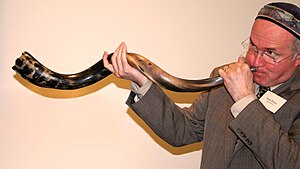
This is another in a series of posts to make Jewish life a little more accessible. Click on “Especially for Beginners” in the menu on the right side of your screen to find more articles about the basics of Jewish living.
Rosh HaShanah, the Jewish New Year, begins at sundown on September 24, 2014. Here are the basic facts to know about the holiday season:
Happy Jewish New Year!
Rosh HaShanah is the Jewish New Year. Observant Jews will go to synagogue that day, and will do no work. Many other Jews may take the day off for reflection and celebration. The mitzvah [commandment] for the day of Rosh HaShanah is to hear the sound of the shofar [ram’s horn.] The basic greeting for the New Year is “Shanah Tovah” [literally, “Good Year!”]
Days of Awe
Rosh HaShanah begins a very serious time in the Jewish year called the Days of Awe. Unlike the secular New Year, which is mostly a time for celebration, the Days of Awe are an annual period for reflection and for mending relationships and behavior. Synagogue services use solemn music and urge Jews, individually and collectively, to mend what is broken in their lives, and to apologize for misdeeds.
Teshuvah: Sin & Repentance
The Jewish understanding of sin is that all human beings fall short of their best selves from time to time. When we do wrong, even inadvertently, we are required to acknowledge what we have done, take responsibility for it, and take steps to assure it will not happen again. This process is called teshuvah [literally, “turning.”]
Yom Kippur
The Day of Atonement, Yom Kippur, is the culmination of the process of teshuvah. Observant Jews fast for 24 hours and spend the day in synagogue, praying and reflecting on their lives. Work is forbidden. Other Jews may take the day off for reflection as well. Yom Kippur is a day for atonement for sins against God and/or Jewish law; it only atones for sins against other human beings if we have gone through the process of teshuvah (taking responsibility, apologizing, and taking steps to prevent a recurrence.) If you have a health problem that requires regulation of food and/or liquids, do not fast – there are other ways to observe.
In the Synagogue
Very important, for newcomers: Rosh HaShanah and Yom Kippur are the days of the year when the greatest number of Jews attend synagogue. However, they are not good days to attend synagogue for the first time. The services are longer than usual and much more solemn. For a first visit to a synagogue, a regular Shabbat service on Friday night or Saturday is much more typical of Jewish practice and belief.
Tickets for Prayer?
Because of the high attendance, many synagogues do not have seats for visitors for their main services. If they have a few extra seats, they sell tickets for those seats to offset the extra expense of the visitors (members pay their share via membership dues.) Note that synagogues often make arrangements for reduced rates for membership for those who wish to participate in synagogue life but who cannot afford full dues. Consider joining a synagogue – they offer much more than High Holy Day services.
There are several options for attending High Holy Day services for low or no cost. You can always call the synagogue and ask; they may be able to make a referral, and there are synagogues who offer free High Holy Day services as a form of outreach. Some synagogues offer free High Holy Day tickets for college students. If you are in a city in the USA, call the Jewish Federation or other local Jewish agency for information about locations for free or low-cost services.
Another option, almost always free, is to attend Selichot services which are usually on the Saturday evening before Rosh Hashanah. You will hear the High Holy Days music, often the clergy will be wearing their High Holy Day robes, but it is an evening penitential service that is so little known that only regulars attend. Call your local synagogue for information.
Get the Most out of Your High Holy Days
To get the most out of the High Holy Days, observe the month of preparation that leads up to them. Attend services at a local synagogue (guests are welcome at regular services). Ask yourself “What about my life and behavior needs to change?” and make those changes. Mend relationships that can be mended, and do your part even in those relationships that cannot be mended at this time. Consider reading a book about the High Holy Days, or keeping a journal. Like everything else in life, the more you invest in this experience, the more you will get out of it.
There is much more to know about the High Holy Days; this is just a beginning. If you are curious about Judaism, this is a great time of year to contact a synagogue about adult education classes, since many things in synagogue start immediately after the holidays.
L’Shanah Tovah: I wish you a fruitful beginning to the New Year of 5775!





